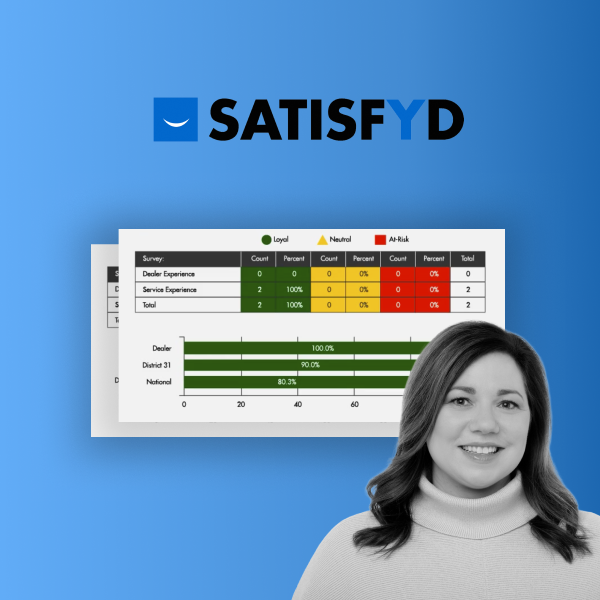No matter the size of your truck and trailer dealership, you need reliable, profitable equipment to effectively serve your customers and keep your business profitable. Monitoring and managing fleet performance requires more than a few cursory evaluations or an annual revenue report.
Tracking specific key performance indicators (KPIs) regularly gives you complete visibility into fleet performance and data-driven insights on how to improve it. Setting — and sticking to — attainable fleet performance benchmarks helps your dealership enhance productivity and control costs. Plus, it gives your employees clear goals to track over time.
In this blog, we’ll share four essential KPIs your dealership can implement to keep a close eye on rental fleet performance.
1. Time Utilization Rate
Your dealership’s rental revenue heavily depends on high rental rates, known in the BI world as the time utilization rate, for each vehicle in your fleet. Time utilization refers to the percentage of time each vehicle spends rented out compared to the number of days it’s available for rent.
Measuring this KPI on a regular basis helps you understand overall fleet performance by identifying the most utilized and least utilized vehicles at your dealership. From there, you can make data-based decisions on which pieces of equipment to keep around, which ones to retire, and the most profitable ways to expand your fleet in the future.
You might even consider investing in an analytics solution that will alert you when your fleet falls below a certain utilization percentage, typically one outlined by your industry or your dealership’s unique KPIs and success metrics. That way, you always have complete visibility into fleet performance and the ability to proactively retire or swap out equipment as its utilization declines.

2. Lifetime Profitability
Lifetime profitability, also known as a piece of equipment’s washout percentage, should be calculated when the equipment is retired and disposed of to help your dealership accurately predict when you’ll need to dispose of the similar remaining equipment in your fleet.
This KPI measures profitability over the life of a truck or trailer, accounting for income and expenses since the vehicle was added to your fleet. In short, this metric calculates cash in versus cash out. It’s an important figure to measure and record so that you have full visibility into all revenue streams and cost centers related to fleet performance, including:
- Purchase prices
- Carrying costs
- Maintenance expenses
- Rental income
- Sales profits
Together, these insights help you add more profitable equipment to your fleet, retire vehicles before they need expensive repairs, and identify opportunities to cut excess costs out of your maintenance plans. Data integration is critical here, as you’ll need to analyze multiple data points to ensure you’re accounting for the full range of expenses and profits each vehicle has accrued over its lifetime.

3. Maintenance-To-Income Ratio
Speaking of maintenance, it’s essential to consider how much you’re spending to keep each vehicle in your fleet in good working order. Maintenance expenses can add up quickly — and take up a significant portion of your overall fleet performance budget.
What’s more, equipment that consistently breaks down can tank customer satisfaction rates and may even prompt your customers to go elsewhere for the rental equipment they need.
Your dealership should keep an eye on maintenance-to-income ratios across your fleet to determine how much it costs to keep each piece of equipment rental-ready compared to how much income it brings in over a set period. This KPI will help you identify equipment that’s consistently out of commission for maintenance so you can retire it from your fleet.
By tracking your fleet’s maintenance costs, history, and age compared to revenue, you’ll be able to eliminate problematic equipment and replace it with more reliable options.
4. Physical Utilization Rate
Physical utilization is similar to time utilization. However, instead of just measuring the time each piece of equipment was rented out, it measures how long each piece was committed to a customer and not available to other customers. This KPI may or may not align with what each customer was actually billed since breakdowns, weather issues, and pre-existing machinery problems can reduce the amount paid.
You can calculate physical utilization by dividing the rental days a piece was committed to customers by its potential rental days. Industry benchmarks for physical utilization vary slightly by industry, but typically, around 70% of a fleet should be out on rent at any given time, 20% should be on the lot and rental-ready, and only 10% or less of the fleet should be non-rental-ready.
Low physical utilization rates often point to problematic machinery with recurring maintenance needs or an abundance of equipment compared to order volume and market needs. Your dealership’s physical utilization rate will help you determine when it’s time to expand or consolidate your fleet to ensure smooth operations and maximize revenue. If your physical utilization is consistently above 70%, you likely need to purchase more; if it’s always below 70%, you likely have too many pieces of equipment on hand.
If a piece of equipment in your fleet consistently spends more than 10% of its time non-rental ready, that unit is a problem. No equipment should ever be out of commission for more than two weeks. If fixing it doesn’t reliably keep it off the hard-down list, it’s likely time to sell it.
Monitor Fleet Performance and Track Critical KPIs Across Departments With TARGIT
The right BI and analytics solution can help your dealership track critical KPIs related to fleet performance, service utilization, sales, and more. By increasing your visibility and access to up-to-date performance insights, you’ll be better equipped to make informed decisions about how and where to expand your truck and trailer dealership.
To learn more about KPI and performance management in the truck and trailer rental industry, download our guide, Impactful Analytics for Truck and Trailer Dealers. Inside, you’ll learn the most valuable metrics to track in every department and explore the top trends driving change for dealers across the globe.
.png)




